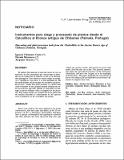Por favor, use este identificador para citar o enlazar a este item:
http://hdl.handle.net/10261/113787COMPARTIR / EXPORTAR:
 SHARE SHARE
 CORE
BASE CORE
BASE
|
|
| Visualizar otros formatos: MARC | Dublin Core | RDF | ORE | MODS | METS | DIDL | DATACITE | |

| Título: | Instrumentos para siega y procesado de plantas desde el Calcolítico al Bronce antiguo de Chibanes (Palmela, Portugal) |
Autor: | Clemente-Conte, Ignacio CSIC ORCID ; Mazzucco, Niccolò CSIC ORCID ; Soares, Joaquina | Palabras clave: | Use-Wear analysis Sickle implements Chalcolithic Iberian Peninsula Heat treatment Tribulum Análisis funcional Elementos de hoz Calcolítico Península Ibérica Tratamiento térmico Trillo |
Fecha de publicación: | 2014 | Editor: | CSIC - Instituto de Historia (IH) | Citación: | Trabajos de Prehistoria (71/2) : 330-342 (2014) | Resumen: | [EN] Micro-wear analysis has been applied to one of the characteristic flint tools types (foicinhas) of the III millennium cal BC in Portuguese Estremadura. Foicinhas have a specific technological and typological character and their function has been discussed long time ago without any positive results. The present use-wear study
makes clear that they are sickles. This provides information about the agricultural practices of the Portuguese Chalcolithic and gives new insights as to the biography
of the foicinhas. This paper highlights the contribution of micro-wear analysis for an integrated socioeconomic approach
to chipped stone tools. [ES] El análisis funcional ha reconocido rastros de uso en artefactos de sílex (foicinhas) que caracterizan la identidad socio-cultural del III milenio cal BC en la Estremadura portuguesa. Esos artefactos tienen rasgos tecnológicos y tipológicos específicos y su funcionalidad ha sido discutida durante mucho tiempo sin resultados positivos. El presente estudio funcional permitió su clasificación como elementos de hoz, proporcionando información sobre las prácticas agrícolas durante el Calcolítico en Portugal y nuevos enfoques sobre la biografía de las foicinhas. Este trabajo supone un ejemplo más de la aportación del análisis funcional al conocimiento de los aspectos socio-económicos en las sociedades del pasado. |
Versión del editor: | http://dx.doi.org/10.3989/tp.2014.12137 | URI: | http://hdl.handle.net/10261/113787 | DOI: | 10.3989/tp.2014.12137 | ISSN: | 0082-5638 | E-ISSN: | 1988-3218 |
| Aparece en las colecciones: | (IMF) Artículos |
Ficheros en este ítem:
| Fichero | Descripción | Tamaño | Formato | |
|---|---|---|---|---|
| Clemente-2014-Instrumentos para siega y procesado de plantas.pdf | 7,09 MB | Adobe PDF |  Visualizar/Abrir |
CORE Recommender
SCOPUSTM
Citations
6
checked on 24-abr-2024
WEB OF SCIENCETM
Citations
3
checked on 14-feb-2024
Page view(s)
401
checked on 24-abr-2024
Download(s)
391
checked on 24-abr-2024
Google ScholarTM
Check
Altmetric
Altmetric
Este item está licenciado bajo una Licencia Creative Commons

